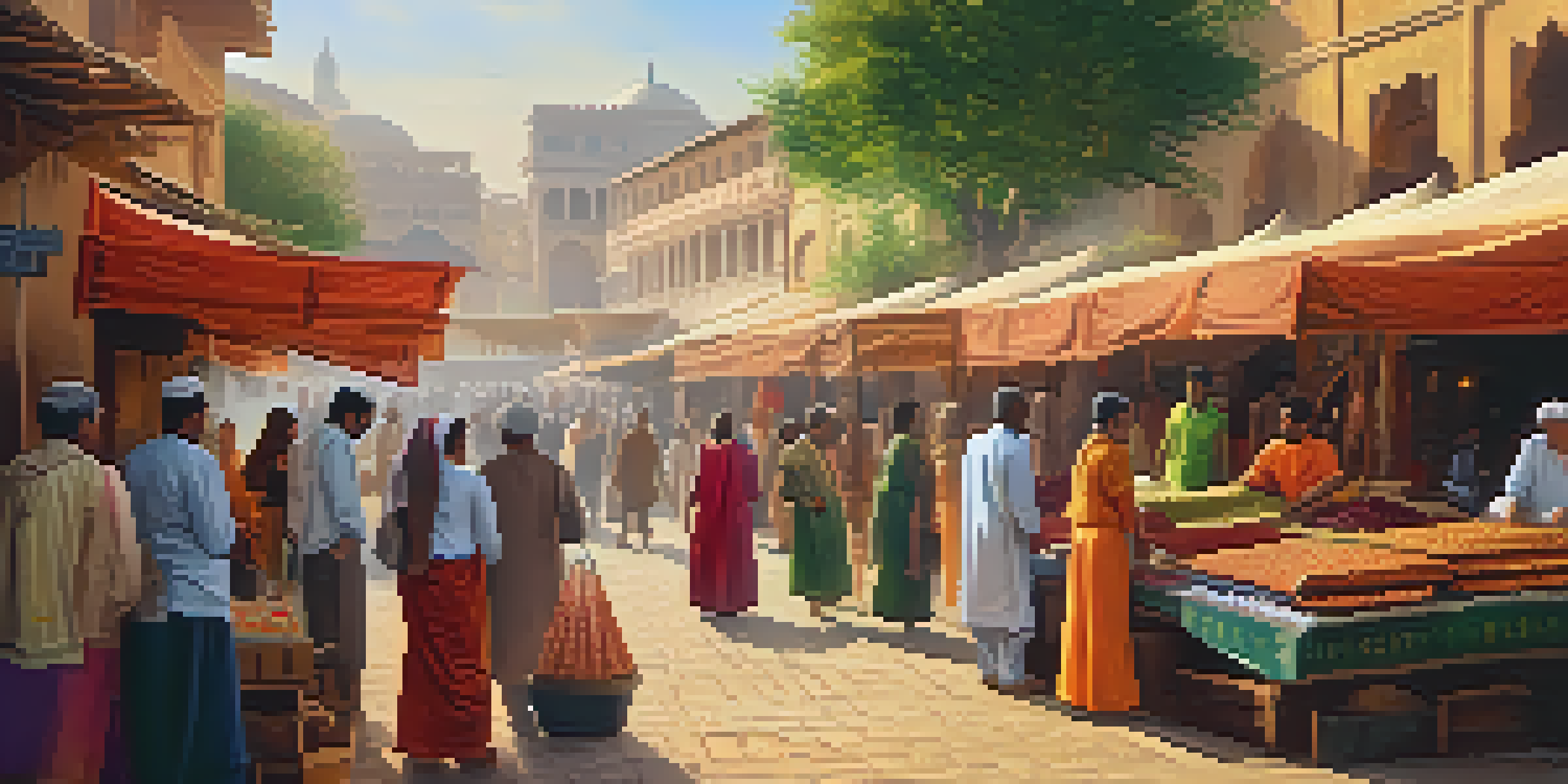Cultural Heritage and the Ethics of Art Reproductions

Understanding Cultural Heritage and Its Significance
Cultural heritage encompasses the traditions, artifacts, and values that define a community's identity. It's not just about old buildings or famous artworks; it includes languages, customs, and even local cuisines. Recognizing the significance of cultural heritage helps us appreciate the unique stories and histories embedded in various cultures.
Cultural heritage is the foundation of our identity and provides a sense of belonging.
When we consider cultural heritage, we must acknowledge that it shapes our understanding of the world around us. It provides a sense of belonging and continuity, linking generations through shared experiences. For many cultures, safeguarding this heritage is essential to maintaining their identity in an increasingly globalized world.
Thus, the preservation of cultural heritage is of utmost importance, as it enriches our collective human experience. It fosters respect and understanding among diverse communities, encouraging dialogue and collaboration. This sets the stage for a more inclusive approach to art and reproductions, influencing how we discuss ethics in this realm.
Art Reproductions: A Double-Edged Sword
Art reproductions can be both beneficial and contentious, serving as a bridge between cultures while also raising ethical questions. On one hand, they make art accessible to a broader audience, allowing people to engage with works they might never see in person. On the other hand, reproducing art can lead to misrepresentation or dilution of the original work's meaning.

Consider how a painting might lose its emotional impact when viewed in a digital format rather than in a gallery. The nuances of texture, color, and scale are often lost, leading viewers to experience it differently than intended by the artist. This raises questions about the authenticity of reproductions and their role in preserving cultural heritage.
Cultural Heritage Shapes Identity
Cultural heritage includes traditions and values that connect communities, providing a sense of belonging and continuity.
Ultimately, while reproductions can democratize access to art, they can also pose threats to the original's cultural context. Striking a balance between accessibility and authenticity is crucial for respecting the integrity of art and its heritage.
Ethical Considerations in Art Reproduction
The ethics of art reproduction involve several key considerations, including consent, attribution, and context. Artists and cultural custodians often have strong opinions about how their work is reproduced and shared. Respecting the wishes of the original creators is vital to ensuring that the reproduction process is ethically sound.
Art is not what you see, but what you make others see.
In many cases, reproducing art without proper attribution can lead to misrepresentation and a loss of credibility for both the artist and the reproducer. Providing clear information about the source of the work and its cultural significance helps maintain the integrity of the original piece. It also fosters a greater understanding of the cultural context in which the art was created.
Moreover, reproducing art in a way that respects its cultural context can enhance the viewer's understanding and appreciation. By acknowledging the origins and traditions behind a piece, we honor the artist’s intent while fostering a deeper connection between the artwork and its audience.
The Role of Technology in Art Reproductions
Advancements in technology have revolutionized how we create and share art reproductions. High-quality scanning and printing methods now allow for incredibly detailed reproductions that can capture the essence of the original work. Virtual reality and augmented reality are also emerging as innovative ways to experience art, making it more immersive than ever.
However, these technologies also present ethical dilemmas. For instance, the ability to digitally manipulate an artwork raises questions about authenticity and the potential for misrepresentation. As we navigate these new tools, it's important to consider how they can both enhance and challenge our understanding of cultural heritage.
Ethics in Art Reproduction Matter
Respecting the wishes of original creators and understanding cultural context is vital for ethical art reproduction.
Ultimately, technology can serve as a powerful ally in the preservation and dissemination of cultural heritage. By using these tools responsibly, we can create engaging experiences that honor original works while making them accessible to a global audience.
Cultural Appropriation vs. Cultural Appreciation
Understanding the difference between cultural appropriation and cultural appreciation is critical in discussions about art and heritage. Cultural appropriation refers to the unacknowledged or inappropriate adoption of elements from one culture by another, often without understanding or respect for their significance. This can lead to the commodification of cultural symbols and a loss of their original meaning.
On the other hand, cultural appreciation involves a respectful and informed engagement with another culture’s practices and traditions. It recognizes the value of cultural exchange and fosters mutual respect. When it comes to art reproductions, appreciating rather than appropriating helps maintain the integrity of the original work and its cultural significance.
Navigating this terrain is essential for artists and reproductions alike. By fostering genuine appreciation rather than appropriation, we can enrich our understanding of diverse cultures and support artists in a way that honors their heritage.
Legal Framework Surrounding Art Reproductions
The legal landscape for art reproductions is complex and varies widely by region. Copyright laws generally protect the rights of artists and their works, but these laws can be challenging to navigate, especially when it comes to reproducing cultural artifacts. Understanding the legal implications is essential for anyone looking to reproduce art, as failing to do so can lead to significant legal repercussions.
Additionally, some cultures have specific laws or protocols governing the reproduction of their heritage. These regulations may stem from a desire to protect sacred or significant artifacts from exploitation. Engaging with these legal frameworks is crucial for ethical reproduction practices and for honoring the rights of the original creators.
Technology Enhances Art Accessibility
Advancements in technology offer new ways to experience art, but raise ethical questions about authenticity and representation.
Educating oneself about the legal aspects of art reproduction not only aids in compliance but also fosters respect for cultural heritage. By doing so, we can ensure that the reproduction process is both ethical and lawful, benefiting artists and communities alike.
Preserving Cultural Heritage Through Responsible Practices
Ultimately, preserving cultural heritage through responsible art reproduction practices is a shared responsibility among artists, institutions, and audiences. By engaging in thoughtful discussions about the ethics of reproduction, we can promote a deeper understanding of cultural significance and the importance of authenticity. This collaborative approach encourages everyone to play a role in protecting and honoring cultural heritage.
Moreover, responsible practices can involve supporting artists and cultural custodians in their efforts to maintain the integrity of their work. Engaging with communities and fostering respectful collaborations can lead to more meaningful art experiences that benefit all parties involved. This not only enriches the cultural landscape but also strengthens community ties.

In conclusion, the intersection of cultural heritage and the ethics of art reproductions presents both challenges and opportunities. By committing to responsible practices, we can ensure that art continues to be a powerful medium for cultural expression while honoring the rich histories that shape our world.